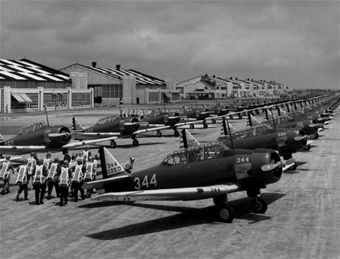 |
| North American BT-9s lined up at March Air Field. These were training aircraft that served with the Air Corps during WWII. |
| Download HiRes |
March Field, originally known as Alessandro Field, was built in response to news stories, circa 1917, regarding German efforts to build a fleet of aircraft. The War Department approved construction of the Alessandro Flying Training Field at an airstrip near Riverside, California, and the Army quickly built it. Quoting from the March Air Field Museum website: "Within a record 60 days the grain stubble-covered plain of Moreno Valley had been partially transformed to include 12 hangers, six barracks equipped for 150 men each, mess halls, a machine shop, a post exchange, a hospital, a supply depot, an aero repair building, bachelor officer's quarters and a residence for the commanding officer."
The facility was renamed March Field in March, 1918, in honor of 2nd Lt. Peyton C. March, Jr., son of the army chief of staff, who was killed in a flying accident the month before. The first troops arrived in April and the first Curtiss JN-4D (a biplane nicknamed the "Jenny") took off from March Field in May.
The armistice ended the war on November 11, 1918, but training continued until military budgets were sharply reduced in 1921. March Field closed in April, 1923. Three years later, Congress created the Army Air Corps and by 1927, funds were appropriated to re-open March and the base was refurbished.
Future Air Force leaders such as Curtis LeMay, Hoyt Vandenberg, Thomas Power and Nathan Twining completed their first flight training at March. But by 1931, flight training had shifted to Randolph Field in Texas and March had become an operational base. By the end of the year, the Condor B-2 and Keystone B-4 bombers arrived. Soon March was home to the 17th Pursuit Group and the 1st Bombardment Wing.
The first permanent buildings were finished in 1934. Following the Japanese attack on Pearl Harbor in 1941, March was again used for training air crews. Quoting from the March Field Air Museum website: "Throughout the war many soon-to-be-famous bombardment groups performed their final training at March before embarking for duty in the Pacific." The base expanded, at one time housing 75,000 troops. March became an Air Force Base when the Air Force became a separate branch of the armed forces in 1947.
Following WW II, March became part of the Strategic Air Command. Headquarters Fifteenth Air Force, the 33rd Communications Squadron and the 22nd Bombardment Wing were located at March. B-29 Superfortresses from March were involved in the Korean Conflict, then replaced by B-47 jet bombers and KC-97s, their refueling tankers.
General Archie Old, commander of the Fifteenth Air Force, made headlines when he led what was called a "Power Flight" of three B-52s in the first non-stop jet around the world flight. It took 45 hours and 19 minutes, arriving at March on January 18, 1957.
The first Reserve unit was assigned to March in 1960, flying C-119s.
During the 1960s, March became home to 16 B-52 bombers and new KC-135 jet Stratotankers. These played a role in the country's nuclear deterrent force, and the 22nd Bombardment Wing also deployed planes to Southeast Asia. The base also "served as a logistical springboard for supplies and equipment en route to the Pacific," according to the March Field Air Museum website.
After the Vietnam War, the 22nd Bombardment Wing became an air refueling wing, using the new KC-10 tanker, which could transport up to 75 people and nearly 170,000 pounds of cargo a distance of about 4,400 miles unrefueled. The KC-10 has six fuel tanks which carry a total of more than 356,000 pounds of fuel - almost twice as much as the KC-135 Stratotanker.
1982 was also the year the California Air National Guard arrived at March, accompanied by F-4Cs.
March was selected for realignment in 1993. In April 1996, most of the active duty Air Force units left March, and about 2,000 acres of the former base became a smaller Air Reserve Base. The remainder of the installation (some 4,500 acres) was closed as part of a nationwide Base Realignment and Closure (BRAC). The whole base transfer of BRAC property was completed in 2007.